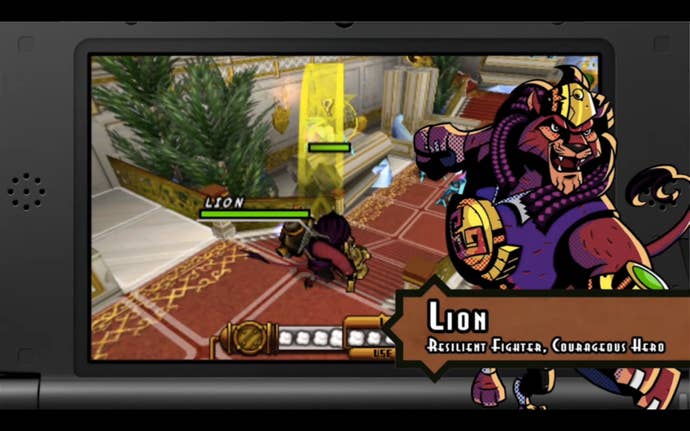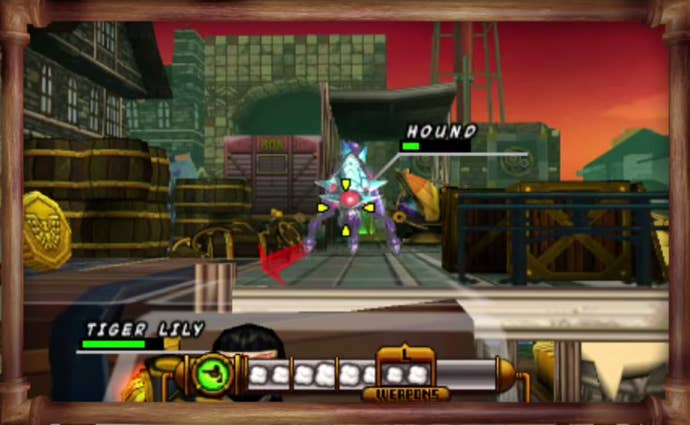Code Name: S.T.E.A.M Nintendo 3DS Review: Mecha Lincoln, Activate
Intelligent Systems' latest strategy game is deeply silly... and really hard.
This article first appeared on USgamer, a partner publication of VG247. Some content, such as this article, has been migrated to VG247 for posterity after USgamer's closure - but it has not been edited or further vetted by the VG247 team.
Code Name: S.T.E.A.M. includes a multiplayer mode, which you can read more about here. Suffice it to say, I like it.
In The Red Badge of Courage, the classic Civil War novel sometimes known as America's first anti-war story, Henry Fleming is a soldier who struggles with what he perceives as cowardice before eventually being able to "rid himself of the red sickness of battle." He returns in Code Name: S.T.E.A.M as a square-jawed Captain America-style hero wielding a steam pack and eagle bombs, which should tell you much of what you need to know about Intelligent Systems' new League of Extraordinary Gentlemen-themed strategy game.

Billed as superhero-style team-up of heroes from classic American literature, the actual source material is mostly incidental to Code Name: S.T.E.A.M's comic book-like story. It's an alien invasion movie, only with Abraham Lincoln standing in for Bill Pullman. Replace Henry Fleming with Gears of Wars' Marcus Fenix and it would hardly miss a beat. Honestly, it's best not to think too hard about the depiction of characters like Fleming in Code Name: S.T.E.A.M. You'll enjoy it more.
Strip away the Victorian Steampunk and characters like Tom Sawyer, though, and you'll find an ambitious handheld strategy game by Intelligent Systems, who are best-known for their work on Fire Emblem and Advance Wars. Code Name: S.T.E.A.M mostly eschews the grid-based movement and overhead perspective of their previous efforts, opting instead for a 3D engine that, energy permitting, grants a full-range of movement. Much of the strategy is derived from the proper positioning of your party of four over the course of each round, making good use of each character's special abilities, and strategically utilizing their weapons to advance to a designated goal.
Not surprisingly, the actual combat system is probably the best part of Code Name: S.T.E.A.M. I like the way that energy can be replenished by retracing your steps, only vanishing permanently if you fire your weapon or wind up getting stunned. Code Name: S.T.E.A.M also has an overwatch mechanic, which is extremely useful for setting up ambushes, though it can make sneaking up on enemies painfully difficult. What I like most about Code Name: S.T.E.A.M, though, is that most every character feels wholly distinct from the the rest of the group, with Lion being able to launch himself over walls, and the Scarecrow being able to launch pumpkin bombs that can explode and stun enemies. The distinctive characters in turn lend extra weight to the process of selecting a party. As the pool deepens and sub-weapons like the three-way Shuriken Shot and the Medi-Carbine become available, you'll find yourself experimenting a lot to find the best possible mix of four characters — always a good sign in a strategy game such as this.

I think it's fair to say that Code Name: S.T.E.A.M gets steadily better as it goes along, gaining momentum as more and more characters join Abraham Lincoln aboard his airship. Unfortunately, it's getting to that point that can be a bit of a challenge. Positive as I've been thus far, I actually have pretty mixed feelings regarding Code Name: S.T.E.A.M's balance, particularly early on, when your options are relatively limited. After easing you in with a handful of tutorial missions, Code Name: S.T.E.A.M proceeds to drop the hammer and become very difficult, which wouldn't really be a bad thing except for a few rather cheesy design decisions, the most noticeable of which is the way enemy reinforcements work.
In Code Name: S.T.E.A.M., you're encouraged to finish maps in a certain amount of time via high scores awarded at the end of each mission. That's all well and good, as well as pretty much par for the course in the genre. Apparently that's not enough motivation though, because if you're slow to finish a map, enemy reinforcements will often start spawning en masse after a certain number of turns have elapsed. It's at its worst in Chapter 4-2 — a mission so irritating that I might well have thrown in the towel right then and there if I had been playing for fun. In Chapter 4-2, you're tasked with finding six frozen refugees scattered around the map, several of which are tucked away behind building and other obscure areas. For the life of me, I simply could not find the sixth refugee, a situation exacerbated by the steady stream of alien reinforcements that would inevitably show up to overwhelm and kill my party. I finally had to ask one of Nintendo's PR representatives for help finding the last refugee for the sake of actually being able to finish this review. I swear, I haven't been this annoyed with a game in quite a while. Just writing about it is giving me heartburn.

The rest of the missions are a bit more forgiving, but nevertheless bring with them their own set of challenges. Maps are loaded with bottlenecks and enemy ambush points, and you will learn to hate the unhittable drones who exist solely to stun your party members and make you waste precious steam that could be better used for... I don't know... moving. The necessarily small maps can also become claustrophobic at times, making it easy to get overwhelmed at a choke point. The margin for error in Code Name: S.T.E.A.M is quite small, and I found myself on more than one occasion sighing and going to restart the map after losing a character to bad positioning or a bit of bad luck. Thank goodness for the large number of checkpoints scattered around each level.
The flipside of all this is that Intelligent Systems has put an impressive amount of work into the design of each map. All are distinct, with tilesets meant to evoke the likes of London, Boston, and Arkham (one instance in which Code Name: S.T.E.A.M actually does leverage its literary trappings). Code Name: S.T.E.A.M's levels also feature plenty of overlooks and secret passageways, the use of which can earn you a decided advantage in battle. On more than one occasion, I found myself wondering how Intelligent Systems managed to squeeze it all in given the relative limitations of the Nintendo 3DS.

The attention to detail afforded Code Name: S.T.E.A.M isn't just limited to the maps, either. The more I played, the more I realized just how good it really looks. I might even go so far as to say that it's actually one of the best looking games on the Nintendo 3DS. Menus in Code Name: S.T.E.A.M. are fully-animated, missions are bracketed by comic book-style cutscenes, and each character has their own unique flourish when using a special attack. Intelligent Systems really didn't skimp with the detail. Mileage will obviously vary when it comes to the art style, which has been contentious from the beginning, but the rest of the presentation is definitely a cut above the rest of the Nintendo 3DS library (ignoring the voice acting, which can thankfully be disabled). They even managed to fit in a fully-controllable first-person rock-em-sock-em battle featuring Mecha Lincoln, which puts an exclamation point on an already meaty game.
As you can probably tell, there's a lot I really like about Code Name: S.T.E.A.M, despite some of my earlier complaints. It's obvious that Intelligent Systems has put a lot of effort into making it as polished a package as possible, cramming in a large amount of content — something I sincerely appreciate. But Code Name: S.T.E.A.M has also left me feeling somewhat conflicted. It's a game that has left me muttering "bullsh*t" more times than I can count, forcing me to restart again and again because I sent one character a little too far down a hallway and they got mowed down by six aliens. I also really hate the reinforcement mechanic. But you know, they're issues I can get around. For what it's worth, Valkyria Chronicles has many of the same problems.
So I'll say that while I have my share of issues with Code Name: S.T.E.A.M's balance, and I'm not a huge fan of the setting, I like it overall. Intelligent Systems has pulled together an impressively comprehensive package, with a scope and polish that occasionally rivals that of a console game. I'm not sure the world was crying out for a steampunk strategy game starring Henry Fleming, John Henry, and Scarecrow, but now that it exists, I say roll with it. Bring on Mecha Lincoln.
VisualsThe art has grown on me. Beyond that, Code Name S.T.E.A.M's presentation is really impressive. Fully-animated menus, some nice cel-shaded graphics, and a handful of solid graphical flourishes really help it stand out on the Nintendo 3DS.
SoundUnless you want to hear John Henry exclaim "Musta heard me clankin' around!" a hundred times, it's best to turn off the voice acting, especially since it detracts from the otherwise strong soundtrack.
InterfaceThe use of the stylus to direct the camera actually works pretty well. The rest of the interface is clean and extremely easy to understand.
Lasting AppealCode Name: S.T.E.A.M's missions include hidden gears that can be used to unlock new items, which hooks nicely into the obsessive compulsive part of the brain. The multiplayer mode is likewise quite substantial, and it comes on top of a lengthy campaign.
ConclusionThere are some things that drive me crazy about Code Name S.T.E.A.M's mission design, and I really think the difficulty balance could have used another pass, but these issues are balanced by the excellent mechanics. Intelligent Systems know their way around the strategy genre, and it shows in Code Name S.T.E.A.M's deep roster and intricate level design. It's more frustrating than it should be in the early going, but stick with it. Silly as it might be, Code Name S.T.E.A.M is ultimately worth it.









